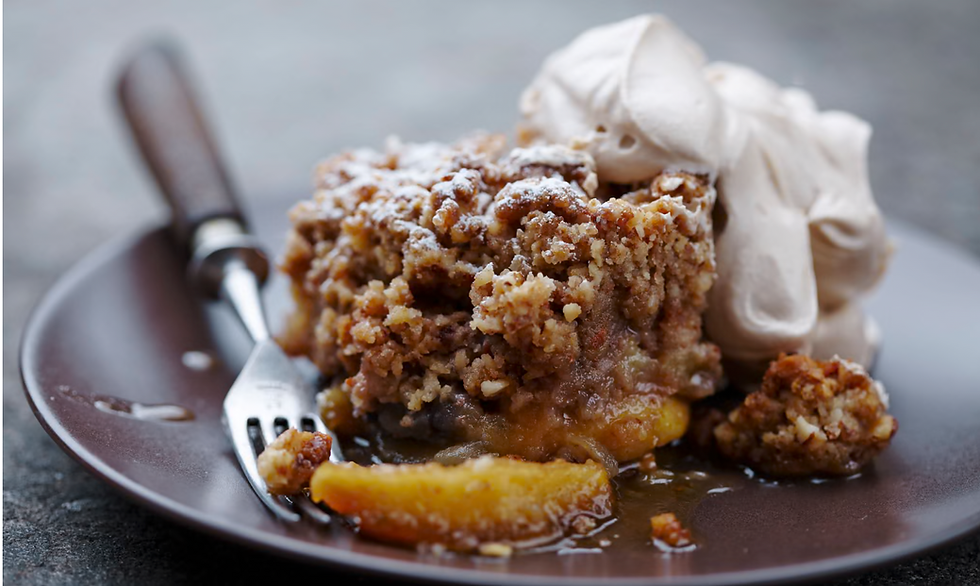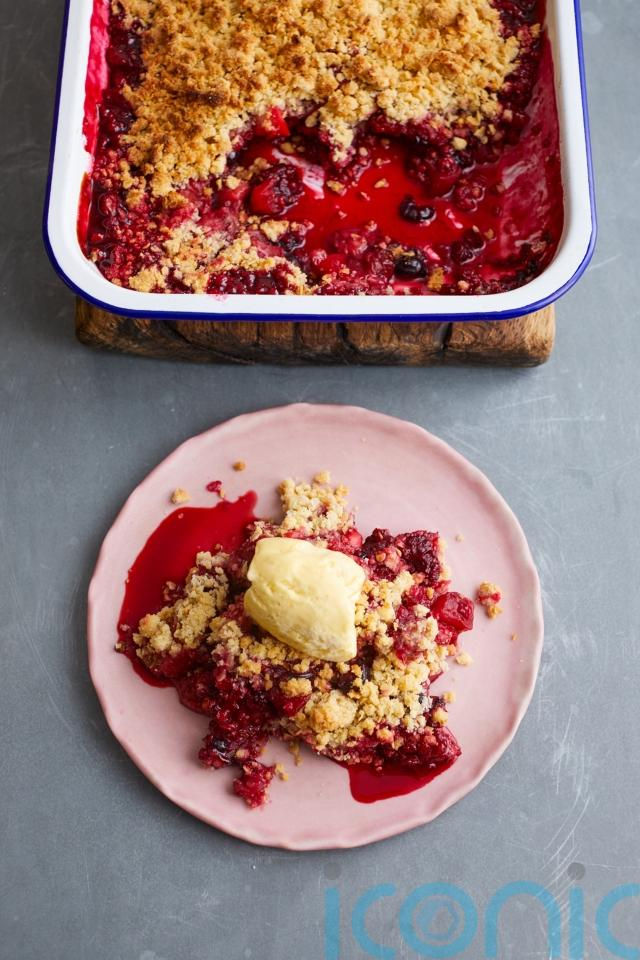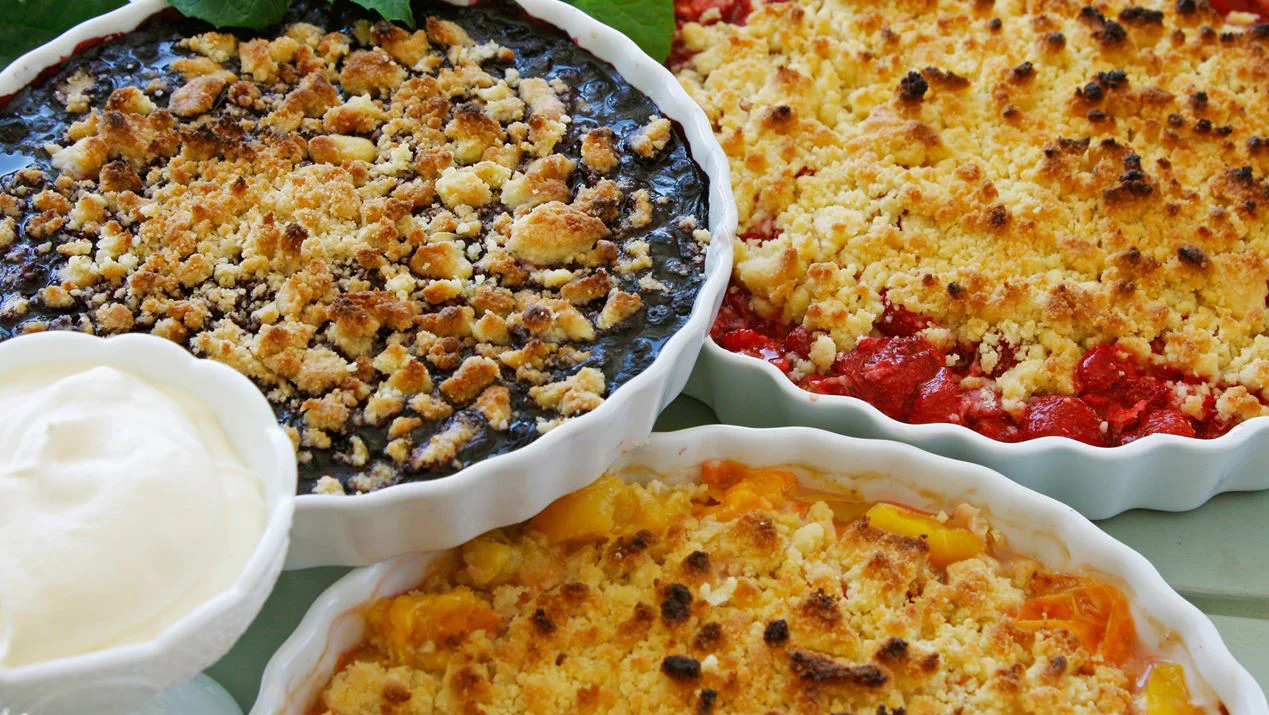"Light heart, light baking" - crumble
- rosemary
- Jul 8
- 5 min read

This post is probably going nowhere. It's just based on a couple of lengthy quotes from Nigel. Here's the last part of it, and I hope this photograph - one of Jamie's crumble recipes illustrates it.
"The crumble is a perfect pudding; the harmony of fruit is hot and slightly sour against the crumble, which is sweet and buttery. The balance of soft and crisp - I could leave it at that. But there is more, and better. In between the fruit and the rubble of the crust lies a layer where the two mingle. It is possibly the most desirable bit of the entire pudding."
As far as I am aware the crumble - a British dish - has no equal in any other cuisine. A cuisine not based on the British one that is. Sure - Americans have apple crisp, and other colonial nations just make crumble, but do the French, the Italians, the northern Africans and Middle Easterns, the Chinese, the Indians, the central and south Americans have similar things?
Cue to do a swift bit of research. Always an interesting exercise and today I learnt, that not only is this a relatively new dish - like, Second World War! but it also potentially not British. For which I submit two, similar pieces of evidence - the first from the highly regarded Oxford Companion to Food by Alan Davidson:
"‘Recipes for crumble do not appear in old books of English recipes, nor is it recorded until the 20th century. Crumble is much quicker and easier to make than pastry and it seems probable that it developed during the Second World War." Alan Davidson/Oxford Companion
During the war because of rationing shortages. And the second from Tony Naylor's How to Eat column in The Guardian:

"Superlative self-care in sweetened fruit and nubbly, buttery topping, the crumble is, for all its seeming inviolability in the Bunterish pantheon of great British puds, a surprisingly new addition to the calorific canon. It may even be an American import of sorts (where it is known as apple crisp), given the earliest print recipes for the crisp-slash-crumble are both found in US cookbooks, in 1924or 1950, depending on who you Google." Tony Naylor/The Guardian
I was aware of apple crisp I have to say, but assumed that it was based on British apple crumble. How provoking to find that it could well be the other way round. Debora Robertson in an article on the Country Life website even lists a whole lot of other, similar American dishes:
"doughy cousins crisps, cobblers, grunts, slumps, buckles, pandowdies and sonkers (such irresistibly sturdy, labradorish names)."
And she forgot Brown Bettys
And Sweden has smulpaj and Germany streusel - and I have to say they do all look similar, although streusel is mostly a kind of cake and Sweden's smulpaj, is perhaps a thinner thing. Below - an apple crisp , smulpaj and streusel.
Even now, having been presented with this evidence I find it hard to believe. It's such a simple thing, that needs no special equipment. We all learn to cook it at an early age don't we?

"I am making crumble. Rubbing butter and sugar together with my fingers and thumb, mixing it with flour and pinch of spice is something I have been doing since I first learned to cook. Crumble was the first pudding I made and I have been making it ever since." Nigel Slater
If it's so simple that even small children can make it - and I do vaguely remember doing this with my children - then surely it was being made way, way back in history. It's a dish for the poor and the peasantry as well. If you have an apple tree, some butter and a little flour and sugar, then you can make it:
"The joy of a good crumble is that modest ingredients are transformed into something magnificent, not that expensive ingredients are transformed into something worthy." Debora Robertson/Country Life
Honestly I just can't believe that it isn't ancient, and also that at least all of the Europeans had versions too.
But back to Nigel and my original impetus for this post. A piece - no two pieces from his wonderful A Thousand Feasts memoir. What else does he say?

"You cut the cold butter into rough cubes and drop it into the bowl of flour ... puft ... puft. Then you start to rub the two ingredients together between your thumb and fingers. The butter slides under your thumb, unrelenting at first, then slowly it forms into thin flakes, then breaks down into pebbles, then gravel, then grit. That is when I stop.
Many years ago, whilst working in the Lake District, I was told to look out of the window at the Lake and daffodils below when making scones or crumble. "Light heart, light baking," I was told."
A sentiment echoed by Tony Naylor in answer to the question, when to make - and eat it - "Whenever life becomes intolerable."
For crumble is indeed the ultimate comfort food perhaps. Comfort in the making too:
"The five minutes or so it takes to monotonously rub the ingredients together gives you time to think about other things, to drift away a little, but I don't. I like to keep a hawk's eye on every stage, to stop just when the texture is perfect, to delight in something so mundane, yet to pudding lovers a very important task indeed." Nigel Slater
Elsewhere I found commentary about how one shouldn't mess with crumble - nothing more than oats in the topping as an extra, and nothing in the filling either. Deconstruction is a sin - as is ice-cream about which many, including most photographers would beg to differ. But I'll just conclude with more of Nigel's words accompanied by one more picture - from Jamie/David Loftus this time - that most resembles what he is talking about:

"The ideal texture of crumbs to top a plum damson or gooseberry crumble is a mixed bag of all sizes, from specks of dust to fat lumps that turn chewy in the heat. Occasionally, after adding the sugar I sprinkle a little water over the surface and shake the rubble from side to side in its bowl, so that some of the crumbs stick together in small pebbles. To do so introduces a more interesting texture than a uniform 'machine made' crust ...
The dish is round and shallow stoneware with a moss-green glaze inside. The crumbs are of assorted sizes, grit, gravel, pebbles and stones. I scatter only enough to proved a thin layer of cover for the fruit, so the crumble will split here and there, giving room for the fruit to bubble up in dark-crimson puddles and scarlet veins like roads on a map."
David and I are both suffering with a cold at the moment, so an apple crumble - well any kind of crumble is a tempting prospect. Alas I don't have the energy. I've probably broken all sorts of copyright by reprinting so much of Nigel, but I'll try and redeem myself by urging you to find a copy somewhere and read it to calm you and dream of other places, other food, that even you might be able to make. On a day like today - dark and wet and pretty miserable, it's a tempting thing to do.
YEARS GONE BY
July 8
2024 - Nothing
2023 - Nothing
2022 - Nothing
2021 - Nothing
2020 - Deleted
2019 - Nothing
2018 - It's not that easy
2017 - Nothing - - the emptiest list so far!







Gooseberry Crumble. My nan used to make it. Grandad grew the gooseberries. Yum